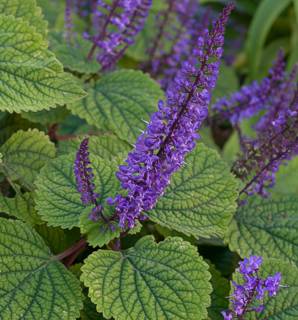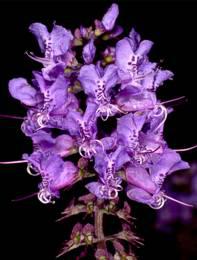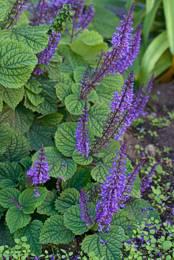Plectranthus fruticosus 'Liana'
Plectranthus fruticosus L'Hérit. 'Liana'
Family: Lamiaceae
Common names: Liana spurflower (Eng.); muishondblaar (Afr.)
Introduction
A striking new cultivar with blue-mauve flowers for shade or semi-sun that will tolerate frost.

Description
Description
Its semi-woody, well-branched perennial growth habit results in a neat and dense rounded shrub around 1-1.5 m high. Like in most members of the Lamiaceae family, the young branches are square in cross section and the leaves are opposite. The Afrikaans common name means skunk-leaf, referring to the pungent odour of the leaves; however, with this cultivar this is not especially noticeable. The dark green leaves are broadly ovate, can reach up to 120-150 mm in diameter, are coarsely toothed along the margin and slightly velvety to the touch. The dark green venation becomes strikingly noticeable on leaves that are exposed to the sun which on the whole become paler. The petioles, 60-80 mm long, are usually green, becoming a light maroon when exposed to the sun.
The inflorescence is in the form of an erect, branched panicle arising from the tips of the branches and in the axils of the uppermost pair of leaves, each panicle reaching up to 300 mm long and supporting approximately 600 flowers, with 6 flowers at each node. The calyx at the base of the flower is green, fading to purple at the mouth, 8 mm long at flowering and enlarging to 12 mm after the flower has dropped.

Each flower is in the form of a tube about 8 mm long with a distinct spur at the base, narrowing to a throat and then flaring open, reflexing at the mouth. The "face" of each flower is mottled with dark purple spots. The brown seeds or nutlets are 1.5 mm long and nested in the base of the calyx. The flowering period starts in early autumn and tails off in late autumn (around mid-March until early May in the southern hemisphere).

Conservation Status
Status
This species is currently not recognized as being threatened in the wild.
Distribution and habitat
Distribution description
The species Plectranthus fruticosus has a remarkably widespread distribution from Caledon in the Western Cape up to the Limpopo province. However, this cultivar, 'Liana', was collected by the author in the vicinity of Warburton near Ermelo in Mpumalanga, a summer-rainfall part of South Africa. Its natural habitat is amongst large boulders and along the edge of wooded thickets where it grows in well-drained and humus-rich soils. In cultivation this plant is best suited to parts of the garden that receive shade part of the day and direct sunlight part of the day. It has the added bonus of also being frost hardy.
Derivation of name and historical aspects
History
Plectranthus is an Old World genus of about 350 species inhabiting warm tropical and subtropical climates principally in the southern hemisphere. Its range extends from sub-Saharan Africa through Madagascar, India and the Indonesian archipelago down to Australia and some Pacific islands. There are 53 species in South Africa. The genus is closely related to the genus Solenostemon.
A French magistrate and keen botanist, Charles Louis L'Héritier de Brutelle, was the first to describe the genus Plectranthus in 1788 based on P. fruticosus as type species. The Scottish botanist Francis Masson, a dedicated plant hunter for the Royal Botanic Gardens, Kew, on a joint plant- collecting expedition with Carl Thunberg to the Cape in 1774, had collected seed from the wild and sent it to William Aiton who raised the seedlings in the glasshouses at Kew. L'Héritier saw the plants and realised that they represented a new genus which he named Plectranthus. Plectron = spur and anthos = flower. He may have been a bit hasty, however, as he later discovered that his new species is in fact the only member of the genus that actually has a spur. The specific name fruticosus means shrubby, which refers to its growth habit. This cultivar is named after Liana May-Harrower, the wife of the author.
Ecology
Ecology
Due to the normally pungent leaf fragrance of this species, it is not readily browsed by herbivorous animals. However, the larval caterpillars of a number of species of moths and butterflies thrive on the leafy parts of the plant. Although pollination has not been witnessed in the wild, it is assumed that the flowers are pollinated by generalist pollinators like bees. During the dry winter months Plectranthus species have the ability to survive extreme drought — they simply wilt and remain in a state of flaccid semi-dormancy until it rains again. This characteristic makes them excellent horticultural subjects.
Uses
Use
There are no known cultural uses of this particular cultivar, but pungent leaves and branches of the species are sometimes hung around the home or rubbed on window sills to ward off flies.
Growing Plectranthus fruticosus 'Liana'
Grow
Plectranthus species are universally recognized in frost-free temperate and subtropical climates as excellent shade plants. They are also often used as house plants, and will often flourish where many plants struggle for lack of sunlight. Amongst the best known of the Plectranthus species is P. fruticosus. Various flower colour forms are known, ranging from blue through mauve to pink. This particular cultivar, P. fruticosus 'Liana', is distinct in that its flower colour is a dark blue-mauve, and in that it tends to have its flowering peak a few weeks later than the other cultivated forms of this species. P fruticosus ''James' is another form often cultivated.
This cultivar is also distinctive in its growth requirements in that it grows most vigorously when it receives a fair amount of direct sun. It will tolerate shade happily but the growth rate will be much slower and the flowers will be paler. In nature the plant will survive for about 5 years but this can be increased in cultivation through regular pruning.

Plectranthus species are among the easiest and most rewarding of all plants to cultivate and this cultivar is no exception. Cuttings can be made at any time of the year, but preferably in summer, consisting of short pieces of stem having about 3 or 4 nodes. Strip all but the uppermost leaves from the stem and trim them down to about 40 mm² each to reduce transpiration. No rooting hormone is required. During the cool winter and spring months the cuttings can be stuck directly into the ground where you want the plant ultimately to grow. This method works as long as the cuttings are watered every two days or so during the first two months. Alternatively, cuttings can be struck in any rooting medium in pots or cutting trays under the protection of a nursery structure or propagation bench with regular watering or misting.
In order to retain the superior growth characteristics and flower colour of P. fruticosus `Liana', it is recommended to propagate it only vegetatively via cuttings. Should seed form, sow them in a well-drained seedling mix and cover very lightly with a thin layer of pure sand. This can be done at any time of the year but the warmer summer months are best. Seedlings often outgrow cuttings of the same age and are often more robust in their growth habit. The seedlings should be pricked out when they are a few months old and either planted into the ground or potted up.
Plants grow quickly and if planted in spring they should achieve a reasonable size by flowering time in autumn. If planted in late summer, they may not flower in their first autumn. Once the plants have reached a reasonable size, they should be pruned back fairly heavily after flowering in late winter and fed with a good layer of compost and/or organic fertiliser. They will sprout vigorously again in early spring. They require very little other maintenance apart from fairly regular watering at least once a week. Caterpillars and snails seem to be the only real enemies.
References
- Van Jaarsveld, E. 2006. The Southern African Plectranthus: and the art of turning shade to glade. Fernwood Press.
Credits
Adam Harrower
Kirstenbosch Botanical Garden
May 2010
Plant Attributes:
Plant Type: Perennial
SA Distribution: Mpumalanga
Soil type:
Flowering season: Autumn
PH:
Flower colour: Blue
Aspect: Morning Sun (Semi Shade), Afternoon Sun (Semi Shade)
Gardening skill: Easy
Special Features:
Horticultural zones








Rate this article
Article well written and informative
Rate this plant
Is this an interesting plant?
Login to add your Comment
Back to topNot registered yet? Click here to register.